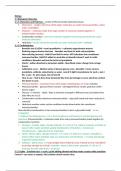Biology
3.1 Biological Molecules
3.1.1 Monomers and Polymers – variety of life but similar biochemical basis
Monomers – smaller units from which larger molecules are made (monosaccharides, amino
acids, nucleotides)
Polymers – molecules made from large number of monomers joined together in
polymerisation reaction
Condensation reaction – joins two molecules together by forming chemical bond, water
molecule eliminated
Hydrolysis – breaks chemical bond and uses water molecules (lysis = splitting)
3.1.2 Carbohydrates
Benedict test (CuSO4) = semi-quantitative -> estimates approximate amount
Reducing sugars donate electrons – Benedict and heat for brick red precipitate
Non-reducing (sucrose) - Add HCl and boil in water, HCl hydrolyses into constituent
monosaccharides, NaHCO3 added to neutralise as Benedict doesn’t work in acidic
conditions, Benedict and heat for brick red precipitate
Starch = iodine dissolved in potassium iodide - blue/black colour change from orange
brown
Calibration curve – dilution series of known glucose conc., Benedict + heat, remove
precipitate, calibrate colourimeter w water, record % light transmissions for each, y axis =
DV, x axis = IV, plot values, line of best fit
How to use – find % first, draw horizontal line from percentage to curve and draw vertical
line down to conc.
Monosaccharides = monomers from which larger carbohydrates are made (soluble)
Monosaccharides – glucose (fruit), fructose = pentagonal (fruit, nectar), galactose (milk) –
hexose sugars
Glucose = 2 isomers – alpha / beta as elements arranged in different ways (Low Body Arms
Hats Who Are You?)
Condensation reaction between monosaccharides -> glycosidic bond and water molecule is
removed
Hydrolysis reaction under certain conditions breaks disaccharide into constituent
monosaccharides
Disaccharides (condensation of two monosaccharides to form a glycosidic bond) – all are
C12H22O11
1. Maltose (two alpha glucose, 1-4) 2. Sucrose (glucose and fructose) 3. Lactose (glucose and
galactose) Polysaccharides = molecules made from many monosaccharides joined together by
condensation reactions
1. Glycogen - animals, alpha, storage molecule, 1-4 / lots of 1-6, coiled so compact, insoluble so
doesn’t affect water potential, quickly hydrolysed bc of branches = enzymes act
simultaneously – alpha glucose for respiration
2. Starch - plants, alpha, storage molecule, 1-4 / some 1-6, helical so compact, insoluble so
doesn’t affect water potential, large so cannot leave cell membrane -> in seeds and storage
organs like potato tubers
3. Cellulose - plants, beta, 1-4, long straight chains linked by many H bonds to form microfibrils
to provide strength to cell wall, insoluble = doesn’t affect water potential, H / OH on C1
inverted, H bonds collectively = structural
3.1.3 Lipids – Emulsion test -> crush / grind adding ethanol and then water creates white emulsion
Control = use water as sample, final solution should remain clear
, Energy, water insoluble, electrical insulators - myelin sheath, both insoluble (phospholipid as
whole uncharged)
Triglycerides - condensation between one glycerol C3H8O3 + 3 molecules fatty acids COOHR
= ester bonds
RCOOH= R group saturated / unsaturated hydrocarbon, 3 water molecules produced
Saturated = only single bonds between C-C / unsaturated = double bonds between C-C
(mono/poly-unsaturated)
Saturated fats – more dense, more viscous, higher bp as more IM forces – requires more
energy to be broken
Non-polar = not water soluble = osmotic pressure unaffected, high C-H proportion = energy
store
Phospholipid – one fatty acid of triglyceride substituted for phosphate - containing group, 2
fatty acids, glycerol
Phosphate head is polar = hydrophilic, two fatty acid tails are hydrophobic, contains ester
bonds
Bilayer = hydrophilic heads on outside, hydrophobic tails on inside, transfer of lipid-soluble
substances
Proteins – Biuret test -> NaOH and few drops of Copper II Sulphate = blue to mauve
3.1.4.1 Properties
Amino acids = monomers from which proteins are made (amine group, side chain and
carboxyl group)
Twenty naturally - occurring amino acids common in all organisms differ only in side group -
evolution evidence
Primary Structure /1^ Sequence of amino acids Peptide bonds between
amine group of one amino
acid and carboxyl group of
another amino acid.
Secondary Structure /2^ Polypeptide chain is folded Hydrogen bonding between
to give the secondary N-H of one amino acid and
structure. It can be an alpha C=O of another amino acid.
helix or beta pleated sheet.
Tertiary Structure /3^ Further folding of the Bonding between the R
secondary structure to make groups of different amino
a specific (unique) shape acids:
(globular / fibrous)
1.ionic bonding 2. Hydrogen
bonding 3. Disulphide
bonding (covalent)
Quaternary Structure /4^ More than one 1 polypeptide Bonding between the R
chain OR polypeptide chain groups of different amino
interacting with a non- acids:
protein (prosthetic) group
1.ionic - weaker 2. Hydrogen
(e.g. haem iron group in
– weakest 3. Disulphide
haemoglobin)
bonding (covalent) - strong
3.1.4.2 Proteins as Enzymes – biological catalyst




